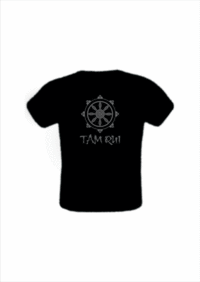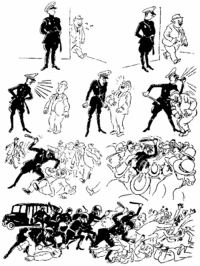Buddhist Prayer Beads
From Buddha World
Buddhist prayer beads are traditional devotional tool used to count mantras while meditating. They are similar to other forms of prayer beads and the Rosary used in various world religions; thus this tool has also been known as the Buddhist rosary.
Mala
A Japa mala' or mala (Sanskrit:माला; mālā, meaning garland) (Tib. threngwa)is a set of beads commonly used by Hindus and Buddhists, usually made from 108 beads, though other numbers, usually divisible by 9, are also used. Malas are used for keeping count while reciting, chanting, or mentally repeating a mantra or the name or names of a deity. This practice is known in Sanskrit as japa. In Tibetan Buddhism, traditionally malas of 108 beads are used. Some practitioners use malas of 21 or 28 beads for doing prostrations. Doing one 108-bead mala counts as 100 mantra recitations. Malas are mainly used to count mantras. These mantras can be recited for different purposes linked to working with mind. Material can vary according to the purpose of the mantras used. Some beads can be used for all purposes and all kinds of mantras. These Beads made of Bodhi seed or wood. Appeasing mantras should be recited using white-colored Malas. Materials such as crystal, pearl or mother of pearl are preferable. These can serve to purify mind and clear away obstacles like illness. There are 100 beads on this Mala. Increasing mantras should be recited using Malas of gold, silver, copper or lotus seeds and with 108 beads. The mantras counted on these can “serve to increase life span, knowledge and merit.” Mantras for overcoming are made of sandal wood, saffron or so. There are 25 beads on this Mala, used to tame others, but with the motivation unselfish to help other sentient beings. To Tame by forceful means, means to subdue harmful energies, such as “extremely malicious spirits, or general afflictions”. Malas for these mantras are made from raksha seeds or even human bones, with 60 beads on the string. in a string of sixty. Only a person who are motivated by great compassion for all being, including those they try to tame, can do this. The string should consist of nine threads, symbolizing Buddha Vajradhara and eight Bodhisattvas. The large bead symbolizes Wisdom, and the cylindrical bead symbolizes emptiness, that all obstacles are overcome.
Usage
Mantras are typically repeated hundreds or even thousands of times. The mala is used so that one can focus on the meaning or sound of the mantra rather than counting its repetitions. One repetition is usually said for each bead while turning the thumb clockwise around each bead, though some traditions or practices may call for counterclockwise motion or specific finger usage. When arriving at the head bead, one turns the mala around and then goes back in the opposing direction. This makes using the mala easier as the beads will not be so tight on the string when you use them. If more than 108 repetitions are to be done, then sometimes in Tibetan traditions grains of rice are counted out before the chanting begins and one grain is placed in a bowl for each 108 repetitions.[citation needed] Each time a full mala of repetitions has been completed, one grain of rice is removed from the bowl. Often, practitioners add extra counters to their malas, usually in strings of ten. These may be positioned differently depending on the tradition; for example some traditions place these strings after every 10th bead. This is an alternative way to keep track of large numbers, sometimes going into the hundreds of thousands, and even millions.
Juzu
In Japanese Buddhism, they are known as "juzu" (counting beads) or "nenju" (thought beads), and both words are usually preceded by the honorific 'o-' (as in "o-juzu"). Female speakers make use of the honorific o- more often than male speakers.
Shu zhu
Chinese court beads (Chinese: pinyin: cháozhū) In Chinese culture such rosaries are named shu zhu ("counting beads"), Fo zhu ("Buddha beads"), or nian zhu ("prayer beads"). Chinese court beads (Chinese: pinyin: cháozhū) also derive from Buddhist prayer beads.
Ba-di
Theravada Buddhists in Burma also use prayer beads, called ba-di [bədí]. Such beads are typically made of fragrant wood, with a series of brightly-coloured strings at the end of the beads.
Numbers and Symbolism
In traditional Buddhist thought, people are said to have 108 afflictions or klesas. There are six senses (sight, sound, smell, taste, touch, and consciousness) multiplied by three reactions (positive, negative, or indifference) making 18 "feelings." Each of these feelings can be either "attached to pleasure or detached from pleasure" making 36 "passions", each of which may be manifested in the past, present, or future. All the combinations of all these things makes a total of 108, which are represented by the beads in the ojuzu[4]. This same number is also used in Japanese New Year services where a bell is rung 108 times. In addition, practitioners of Vajrayana Buddhism, use the number 108 for a different purpose. After reciting 100 mantras, eight extra mantras are done to compensate for any errors. There are numerous explanations why there are 108 beads, with the number 108 bearing special religious significance in a number of Hindu and Buddhist traditions.






































 Русский
Русский
